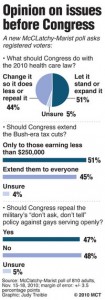 It is hard to understand why voters vote, perhaps because their are a variety of issues and emotions that influence elections. And then there is spin–which has little regard for data as it tries to convince us of an ideological “truth.”
It is hard to understand why voters vote, perhaps because their are a variety of issues and emotions that influence elections. And then there is spin–which has little regard for data as it tries to convince us of an ideological “truth.”
New polling results McClatchy Newspapers reported by Steven Thomma suggest that the midterm elections were not a mandate on specific policies.
“A majority of Americans want the Congress to keep the new health care law or actually expand it, despite Republican claims that they have a mandate from the people to kill it, according to a new McClatchy-Marist poll.
The post-election survey showed that 51 percent of registered voters want to keep the law or change it to do more, while 44 percent want to change it to do less or repeal it altogether.
“Driving support for the law: Voters by margins of 2-1 or greater want to keep some of its best-known benefits, such as barring insurers from denying coverage for pre-existing conditions. One thing they don’t like: the mandate that everyone must buy insurance.”
“At the same time, the survey showed that a majority of voters side with the Democrats on another hot-button issue, extending the Bush era tax cuts that are set to expire Dec. 31 only for those making less than $250,000.”
This should not be surprising–I’ve posted a couple of polls here that have shown there is a strong sentiment that the rich should be taxed. And the Bush era tax cuts definitely favored the rich–it was not an equal tax cut.
And when asked about specific benefits, such as requiring health insurance provide coverage for pre-existing conditions, a majority of even Republicans and self-identified Tea Partyers want to keep it.
The one provision where there was across the support opposition was the requirement that everyone must buy insurance. 65% said it was unconstitutional, while only 29% said this provision should be kept.
METHODLOGY
This survey of 1,020 adults was conducted Nov. 15-18. Adults 18 and older residing in the continental U.S. were interviewed by telephone. Telephone numbers were selected based upon a list of telephone exchanges from throughout the nation. The exchanges were selected to ensure that each region was represented in proportion to its population. To increase coverage, this land-line sample was supplemented by respondents reached through random dialing of cell phone numbers. The two samples were then combined. The margin of error is plus or minus 3 percentage points.
There are 810 registered voters. The results for this subset have a margin of error of plus or minus 3.5 percentage points. There are 371 Democrats and Democratic leaning independents and 337 Republicans and Republican leaning independents. The results for these subsets have margins of error of plus or minus 5 percentage points and plus or minus 5.5 percentage points, respectively. The error margin increases for cross-tabulations.
Read more: http://www.mcclatchydc.com/2010/11/22/104152/poll-majority-of-americans-want.html#ixzz16Djzoh1f